Identifying brown birds, sometimes referred to as LBJs (little brown jobs), can be a challenging task due to their lack of distinct characteristics compared to their more vibrantly-hued counterparts.
However, don’t despair. This handbook will guide you through the process of recognizing a sparrow, a wren, or any other brown bird you might come across. Plus, it will let you know about the different brown birds that can be spotted in Florida throughout the year.
This manual aims to help you distinguish the brown birds that frequent your backyard or that you might encounter in the forests and meadows. The birds are ranked from the most common to the rarest, based on data collected from birdwatcher checklists submitted to ebird for Florida.
Seasonal Distribution of Brown Birds in Florida
Permanent Residents in Florida: The list of brown birds that can be seen throughout the year includes the Northern Cardinal, Mourning Dove, Carolina Wren, Common Yellowthroat, Great Crested Flycatcher, Brown Thrasher, Eastern Towhee, House Finch, House Sparrow, Brown-headed Cowbird, and the Northern Flicker.
Winter Visitors to Florida: During the winter season, Florida hosts brown birds such as the Eastern Phoebe, House Wren, American Robin, American Goldfinch, Chipping Sparrow, Savannah Sparrow, Cedar Waxwing, Swamp Sparrow, Northern Waterthrush, Marsh Wren, Hermit Thrush, Song Sparrow, White-throated Sparrow, White-crowned Sparrow, Pine Siskin, Field Sparrow, Purple Finch, Winter Wren, and the Brown Creeper.
Migratory Birds Spotted in Florida: During the migratory season, birds such as Swainson’s Thrush, Rose-breasted Grosbeak, Louisiana Waterthrush, and Wood Thrush make an appearance.
Rare or Unexpected Species in Florida: On rare occasions, birdwatchers may spot species like the Spotted Towhee, Golden-crowned Sparrow, Bewick’s Wren, and the American Tree Sparrow in Florida.
38 Brown Birds In Florida
1. Northern Cardinal – Female
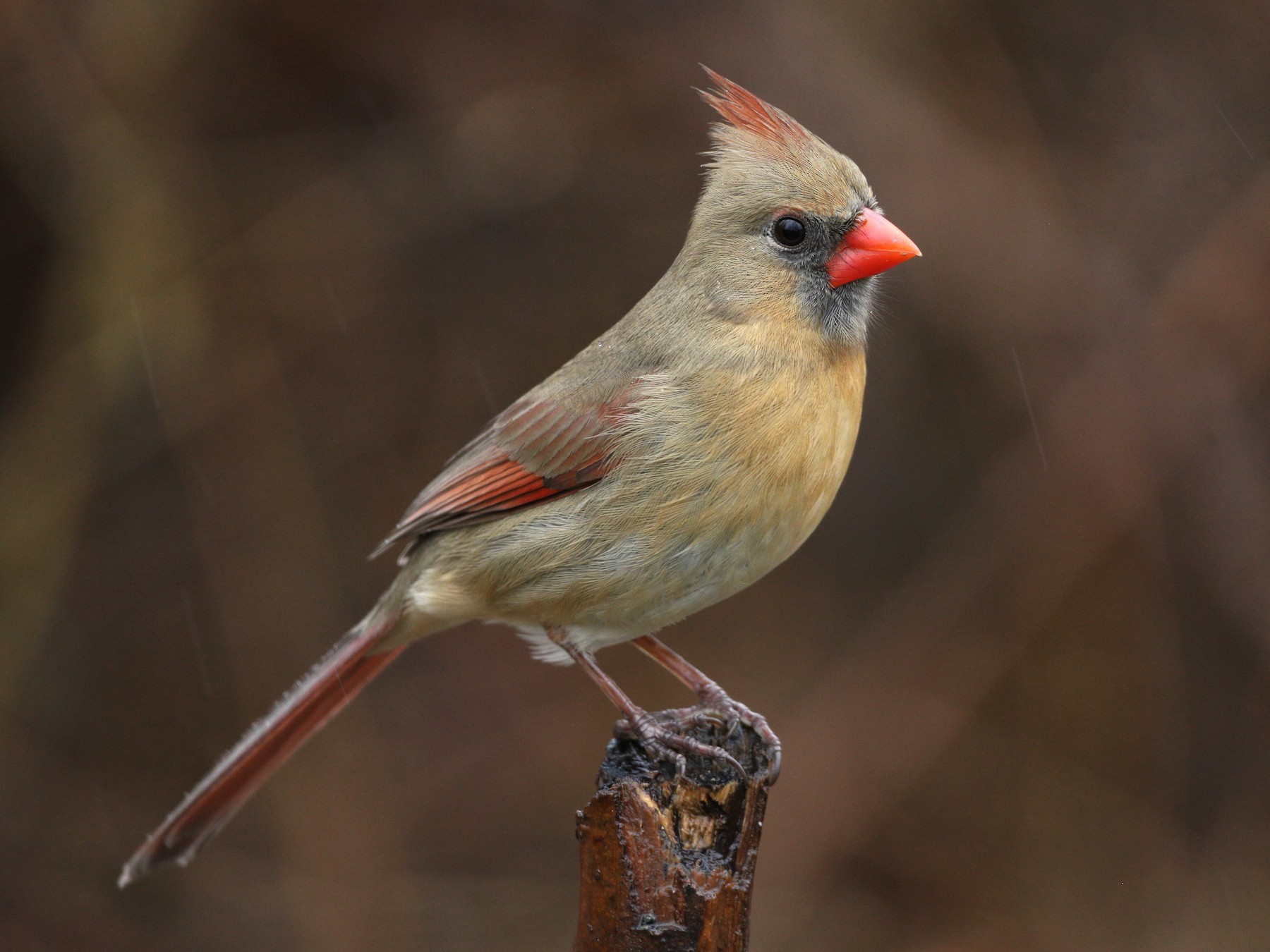
Brown Birds in Florida: A Focus on the Northern Cardinal
The Northern Cardinal, a year-round inhabitant of Florida, is a familiar sight. Summer checklists show them in 55% of entries, and they appear on 39% of winter checklists, as reported by local birdwatchers.
The female Northern Cardinals, with their brown plumage, notable brown crest, touches of red, and red beaks, offer a somewhat flashy appearance.
In contrast, the males, sporting vivid red feathers with black accents around their faces, are a striking sight, especially when set against a snowy winter backdrop. They too possess red crests and beaks.
Scientific name: Cardinalis cardinalis Dimensions: Length: 8.3-9.1 inches (21-23 cm) Weight: 1.5-1.7 ounces (42-48 g) Wingspan: 9.8-12.2 inches (25-31 cm)
The habitat of the Northern Cardinal spans the eastern half of the United States, and extends as far west as Arizona in the southern regions.
Northern Cardinals are typically found amidst dense vegetation, where they search for seeds, fruits, and insects. During the breeding season, they might occasionally attack their own reflection in an obsessive effort to protect their territories.
To encourage Northern Cardinals to visit your backyard, consider setting up feeders filled with sunflower seeds, peanut hearts, millet, and milo. These birds are comfortable feeding from large tube feeders, hoppers, platform feeders, or even picking up food scattered on the ground.
2. Mourning Dove
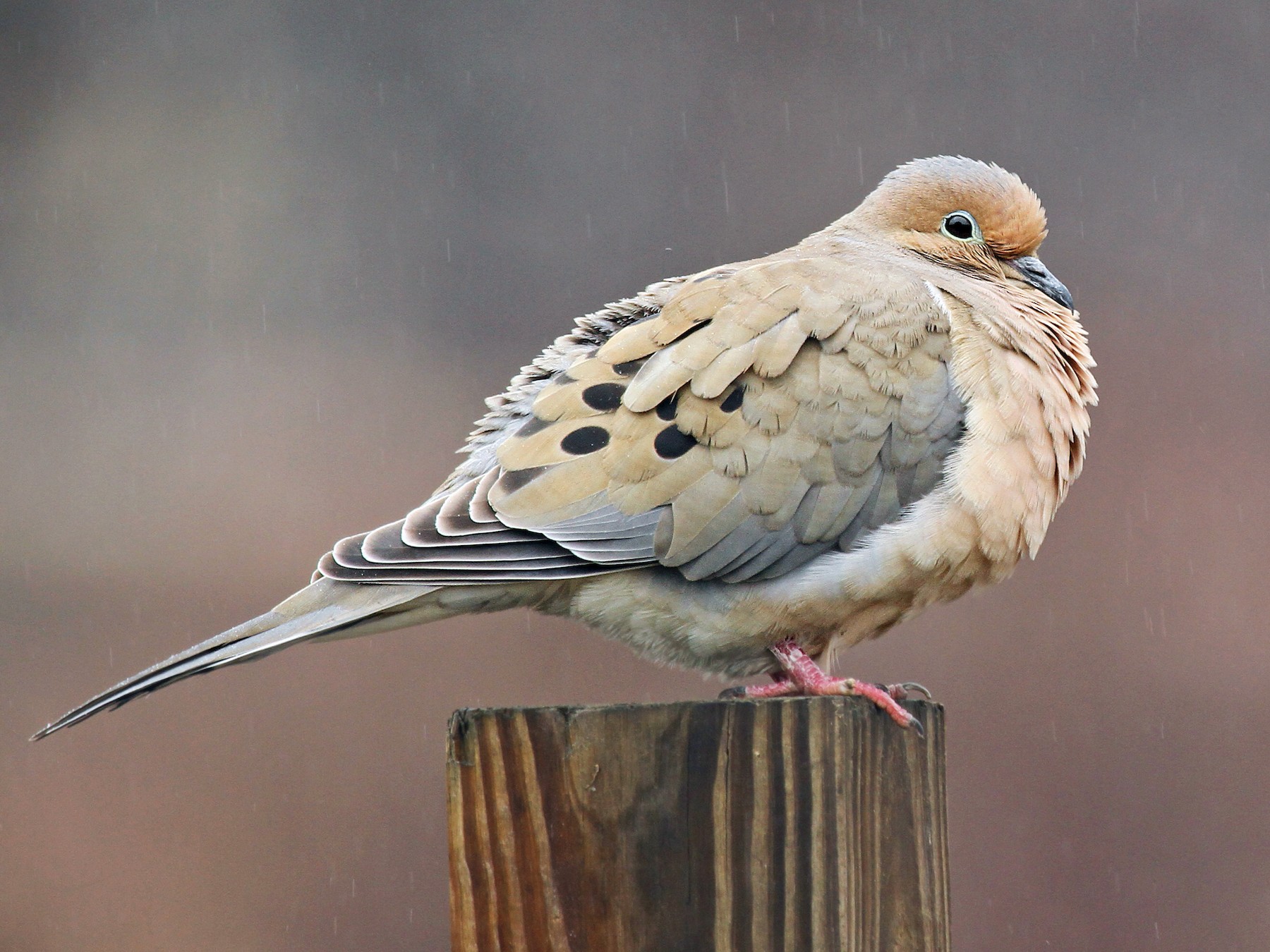
Florida’s Brown Birds: A Closer Look at the Mourning Dove
Mourning Doves are year-round inhabitants of Florida, with a pronounced presence from February through October. They appear on 50% of summer bird-watching checklists and 37% of winter lists.
These elegant birds display small heads, full bodies, and long tails, coated in a soft brown hue marked with black spots on the wings. Male Mourning Doves are typically slightly heavier than their female counterparts.
Scientific name: Zenaida macroura Dimensions: Length: 9.1-13.4 inches (23-34 cm) Weight: 3.0 -6.0 ounces (96-170 g) Wingspan: 17.7 inches (45 cm)
Though prevalent across the lower 48 states throughout the year, Mourning Doves in the northern Midwest and southern Canada often migrate after breeding season.
You can spot Mourning Doves perching on telephone wires or scavenging for seeds on the ground in grasslands, fields, and backyards. They also frequent open areas and edges of woodlands.
If you wish to attract Mourning Doves to your backyard, try spreading millet on the ground or platform feeders. They are also known to eat black sunflower seeds, nyjer, cracked corn, and peanut hearts.
3. Carolina Wren
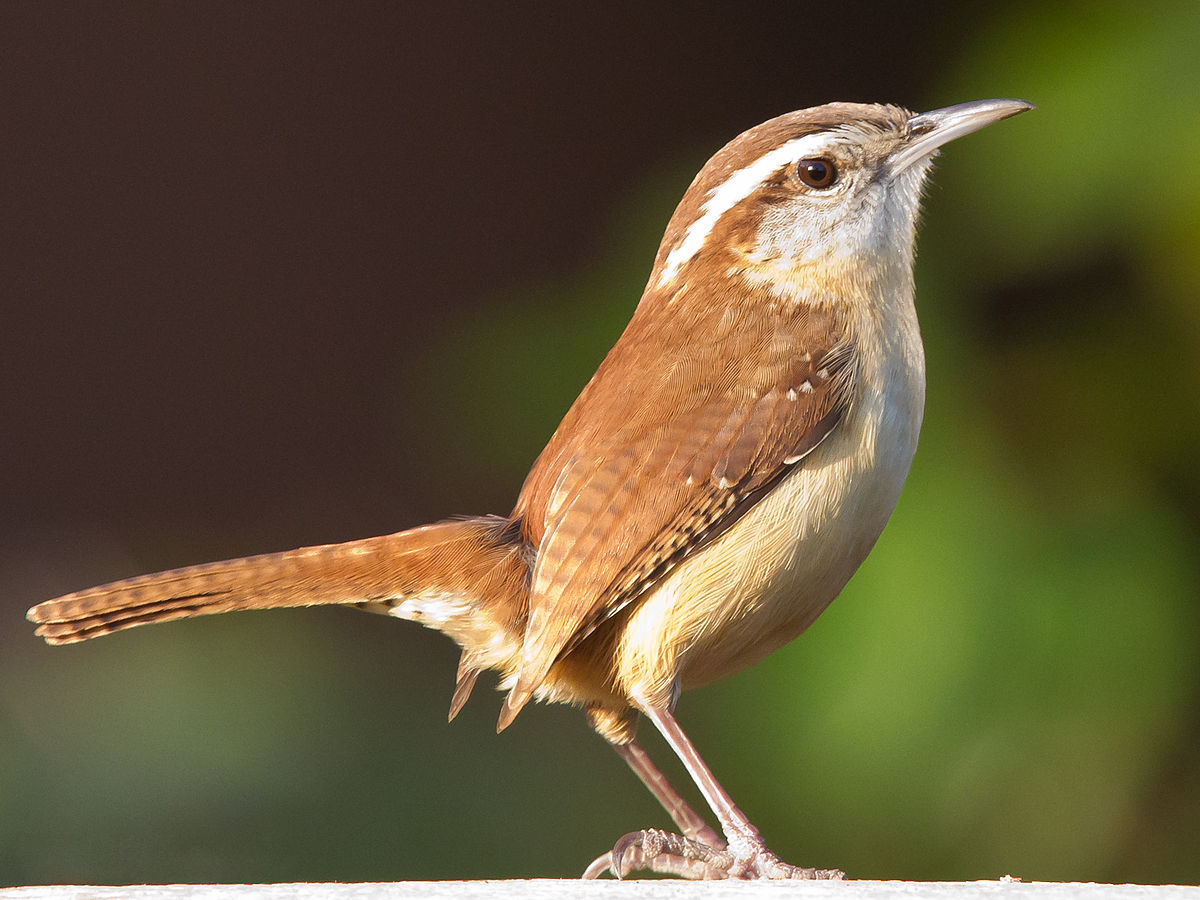
Florida’s Brown Birds: Spotlight on the Carolina Wren
The Carolina Wren, a non-migratory bird, can be seen throughout the year in Florida. They are documented in 28% of the summer birdwatcher checklists and 20% of the winter checklists.
Carolina Wrens are reserved birds that boast a dark brown hue on their backs and a lighter brown on their underparts. They can be identified by their distinctive white eyebrow stripe, erect tail, and their notably loud ‘teakettle’ song.
Scientific name: Thryothorus ludovicianus Dimensions: Length: 4.7-5.5 inches (12-14 cm) Weight: 0.6-0.8 ounces (18-22 g) Wingspan: 11.4 inches (29 cm)
Carolina Wrens make their homes throughout the eastern and southeastern US states all year long. They typically reside in wooded areas or regions with thick vegetation and are also known to frequent backyard feeders.
You can lure Carolina Wrens to your backyard feeders using suet feeders, hulled sunflower seeds, or peanut hearts, which can be placed in large tube feeders or on platform feeders.
While some Wrens in Florida are a common sight in backyards, to spot others, you may need to explore more marshy locales.
4. Eastern Phoebe
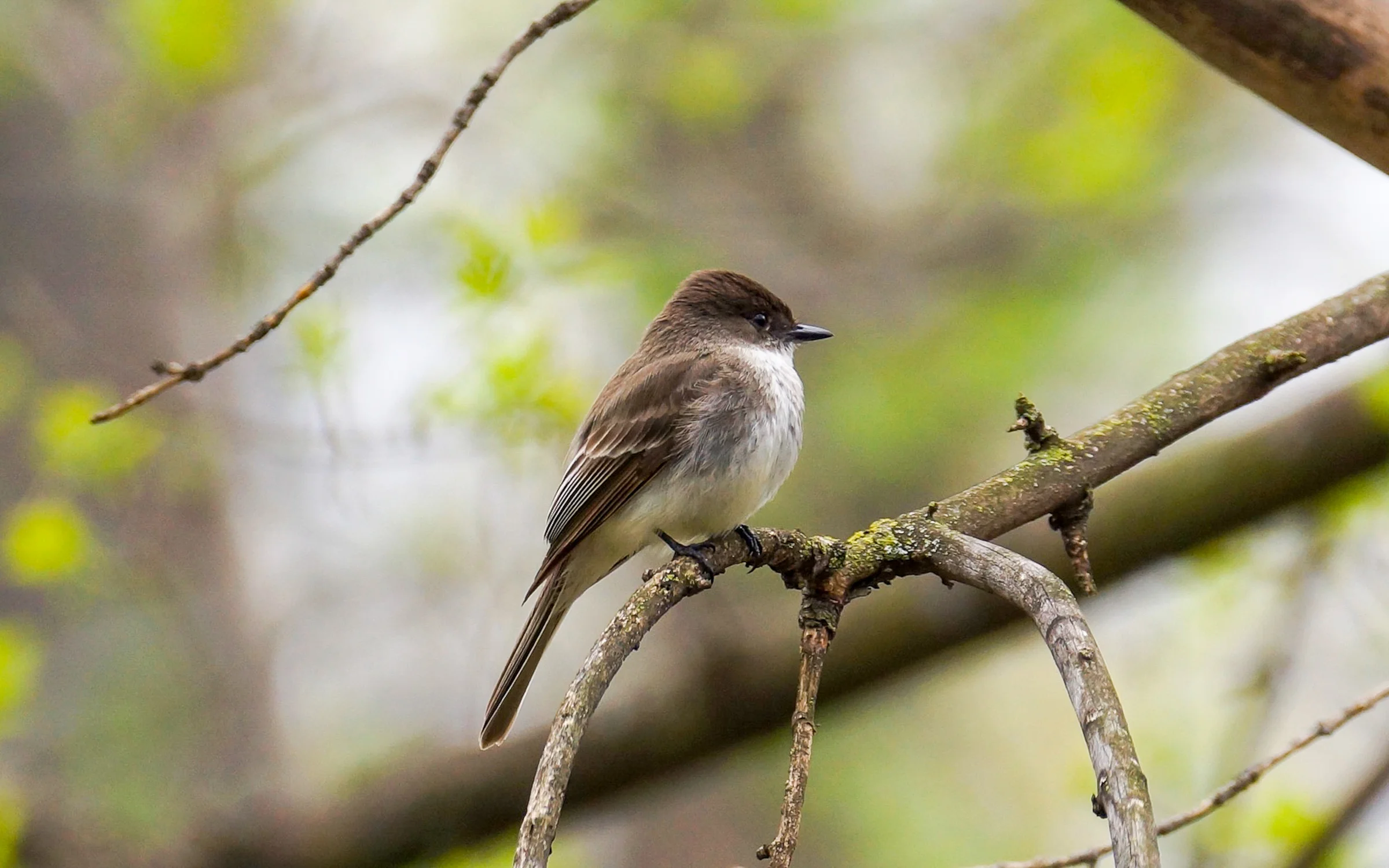
Spotlight on Florida’s Winter Birds: The Eastern Phoebe
Primarily spotted from October through March, the Eastern Phoebe is a winter bird in Florida, making appearances on 26% of winter birdwatcher checklists.
These chubby songbirds flaunt a grayish-brown color on their backs, contrasting with their whitish underparts and darker head.
Scientific name: Sayornis phoebe Dimensions: Length: 5.5-6.7 inches (14-17 cm) Weight: 0.6-0.7 ounces (16-21 g) Wingspan: 10.2-11.0 inches (26-28 cm)
Eastern Phoebes are migratory birds, breeding in northeastern and central US states, including parts of Canada, before heading southwards to the southeastern US states and Mexico for the winter. Some of these birds may remain year-round in the southern parts of their range.
Commonly found alone in tranquil woodland settings, Eastern Phoebes are known for wagging their tails while perched low, rather than being in pairs or flocks.
Primarily flycatchers, their diet largely consists of flying insects. They also consume spiders, other insects, small fruits, and seeds. They frequently nest on man-made structures like bridges, barns, or houses, creating their nests from mud and grass.
To attract Eastern Phoebes to your backyard, consider setting up a nest box or planting native plants that bear berries.
5. Common Yellowthroat
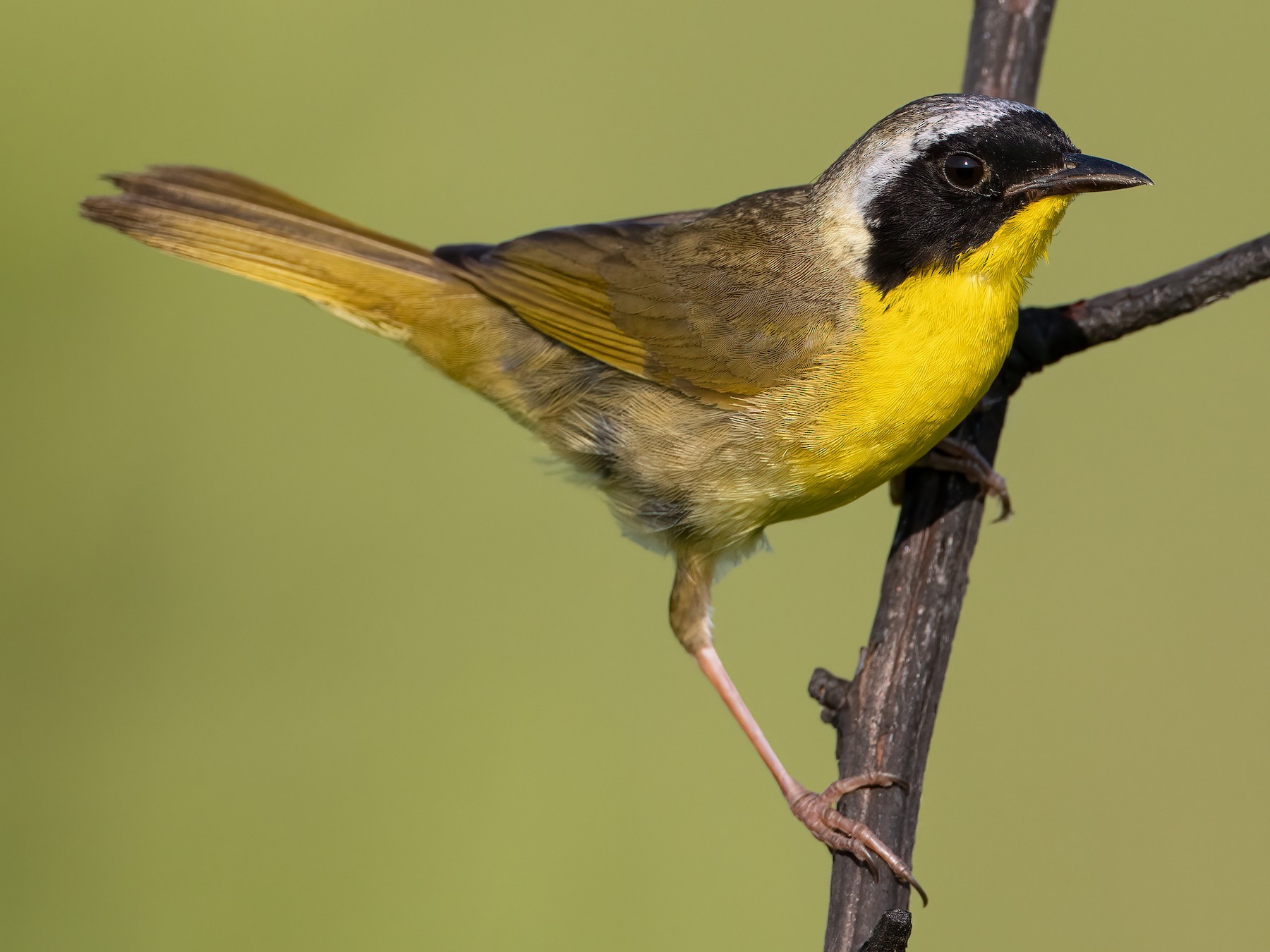
Florida’s Brown Birds: All About the Common Yellowthroat
Residing in Florida throughout the year, Common Yellowthroats are documented on 7% of summer birdwatcher checklists and 11% of winter lists.
These small songbirds exhibit a brownish hue on their backs and bright yellow on their underparts, complemented by their long tails. The males are easily identifiable by their black facial masks. The vibrancy of the yellow color can differ based on geographical location, and they may display more of an olive tint underneath in some regions.
Scientific name: Geothlypis trichas Dimensions: Length: 4.3-5.1 inches (11-13 cm) Weight: 0.3-0.3 ounces (9-10 g) Wingspan: 5.9-7.5 inches (15-19 cm)
Over the summer, Common Yellowthroats breed throughout most of North America, excluding Alaska and northern Canada. Some choose to stay year-round along the Gulf Coast and Pacific Southwest, while others migrate south for the winter.
Common Yellowthroats typically inhabit marshy or wetland areas and brushy fields, preferring to dwell in dense, tangled vegetation.
You can encourage Common Yellowthroats to visit larger backyards by maintaining dense vegetation and growing native plants to draw in insects.
The Common Yellowthroat is just one of the many types of warblers that can be found in Florida. These birds are renowned for their captivating songs, which are a delight to hear and learn.
6. Great-crested Flycatcher
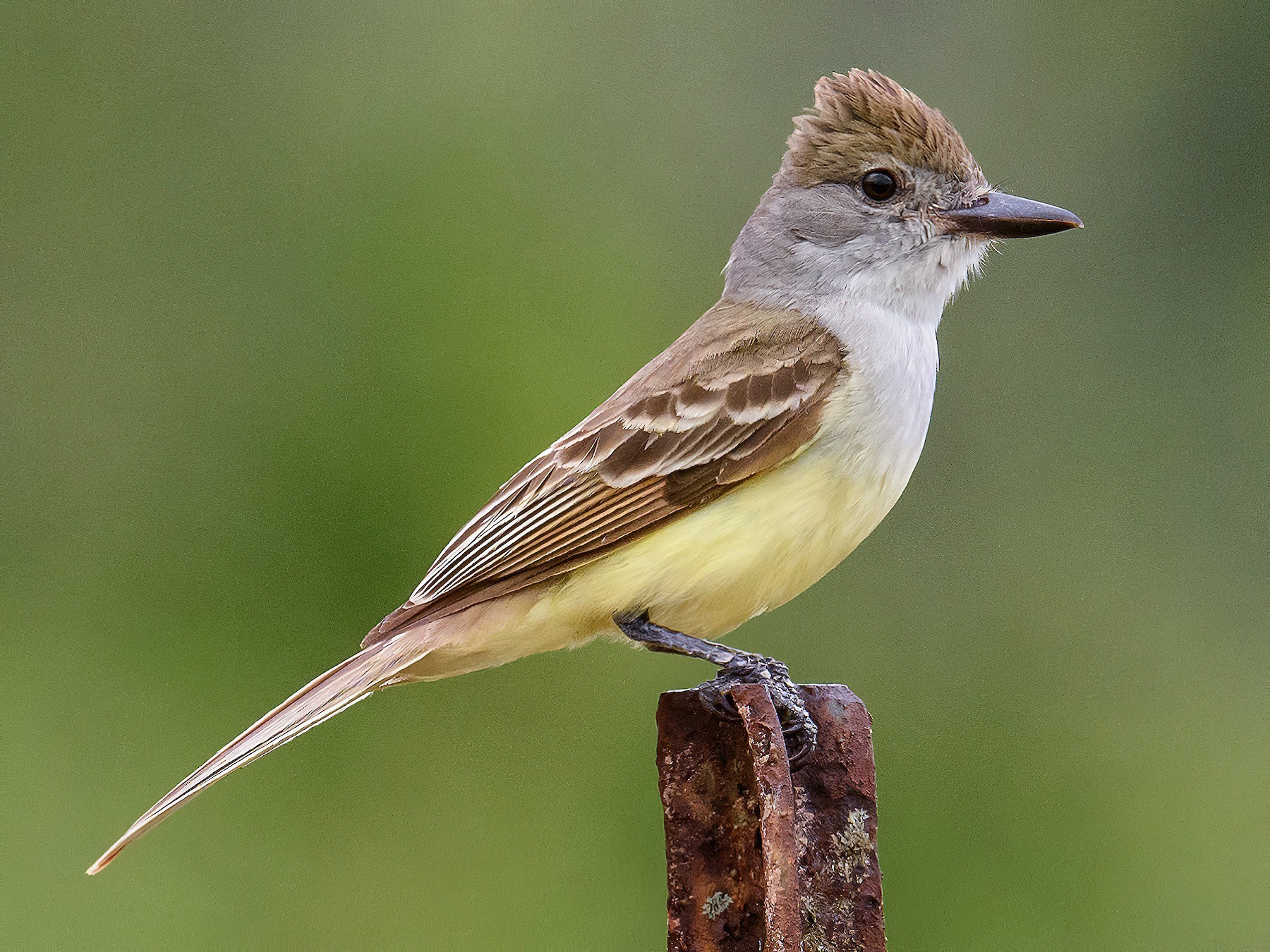
Florida’s Brown Birds: Highlighting the Great Crested Flycatcher
The Great Crested Flycatcher is frequently seen in Florida during the breeding season, from March to September, but also maintains a presence throughout the year. It appears on 22% of summer birdwatcher checklists and a smaller 3% during winter.
Sporting a brown back with a contrasting yellow belly and gray throat, Great Crested Flycatchers are noticeable for their reddish streaks in the wing and tail feathers. Their crest, however, is rather subtle.
Scientific name: Myiarchus crinitus Dimensions: Length: 6.7-8.3 inches (17-21 cm) Weight: 0.9-1.4 ounces (27-40 g) Wingspan: 13.4 inches (34 cm)
These birds breed across much of eastern North America, while winters are spent in the warmer regions of southern Florida, southern Mexico, and Central America.
Predominantly insectivores, Great Crested Flycatchers perch high up in woodlands to ambush large flying insects like butterflies, grasshoppers, moths, wasps, and spiders. They frequent mixed woodlands, park perimeters, tree-lined neighborhoods, or even artificial structures like fence posts. They are also known to consume berries and small fruits.
To entice Great Crested Flycatchers into your backyard, consider cultivating native plant species and maintaining brush piles to draw insects. Planting berry-producing flora and setting up nest boxes are also effective, as they readily make use of these facilities.
7. Brown Thrasher
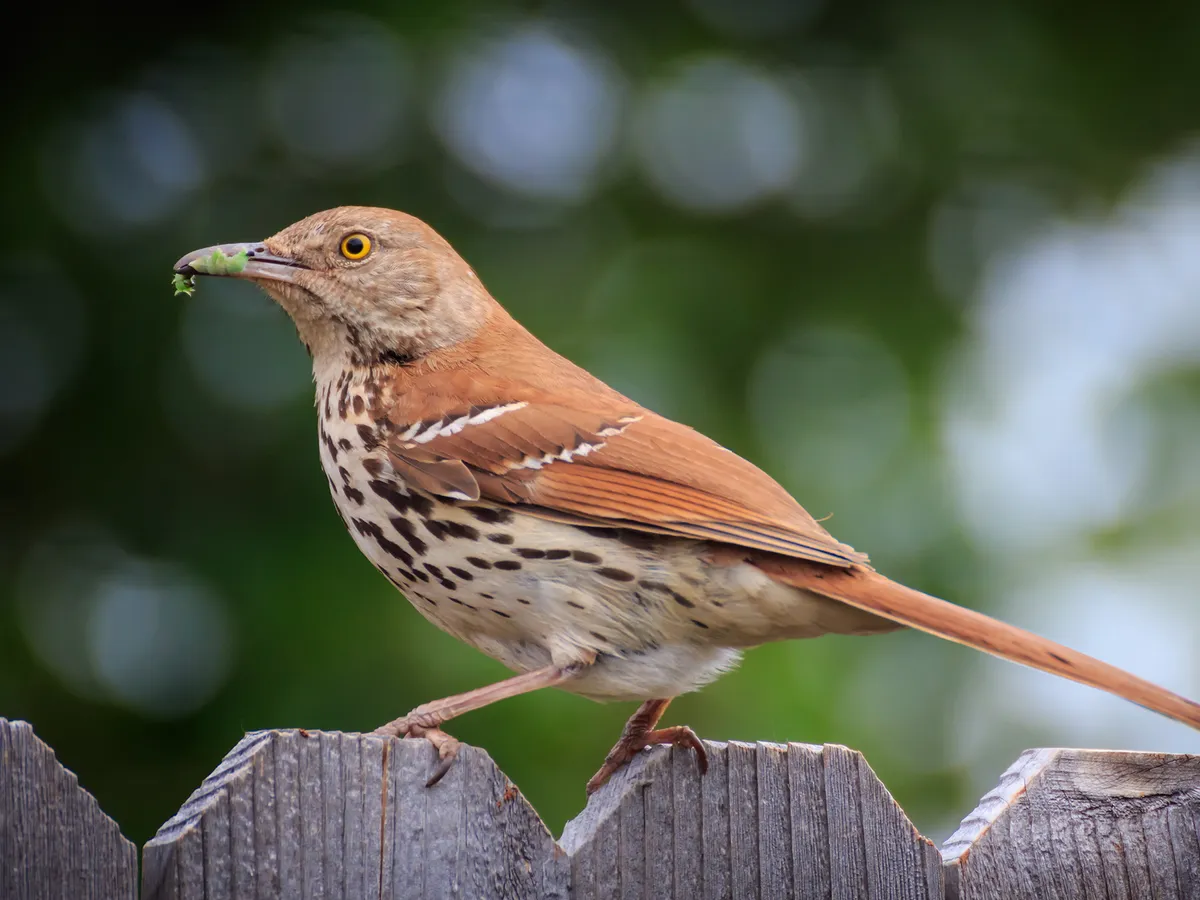
Florida’s Brown Birds: Spotlight on the Brown Thrasher
Brown Thrashers, sizable songbirds comparable to a robin in dimensions, are a constant sight throughout the year in Florida, featuring in 11% of summer birdwatching checklists and 3% during winter.
They sport a brown coat on their back with a streaked white chest and belly. Their faces take on a gray hue, highlighted by their bright yellow eyes.
Scientific name: Toxostoma rufum Dimensions: Length: 9.1-11.8 inches (23-30 cm) Weight: 2.1-3.1 ounces (61-89 g) Wingspan: 11.4-12.6 inches (29-32 cm)
Brown Thrashers inhabit central and eastern North America, with those in the southeast remaining stationary throughout the year. In contrast, those located further north migrate south for the winter season.
Despite their considerable size, Brown Thrashers may prove challenging to spot due to their preference for thickets and shrubbery. However, their presence is often betrayed by the sounds of them foraging on the ground among leaf litter and soil, in search of insects. They also have a varied diet, consuming berries, beetles, and occasionally snatching flying insects from the air.
With an impressive repertoire of over a thousand different song types, they are among the most versatile songbirds in North America.
You can attract Brown Thrashers to your backyard by providing dense cover and planting berry shrubs. They also have a knack for gathering fallen seeds from underneath bird feeders.
8. Eastern Towhee

Florida’s Brown Birds: Highlighting the Eastern Towhee
Eastern Towhees are a perennial sight in Florida, appearing in 9% of summer and 5% of winter birdwatching checklists compiled in the state.
Resembling Robins in size, these strikingly large sparrows feature a black head, throat, and back, along with reddish flanks, expansive tails, and a white belly in males. Females are similarly patterned, although their black areas are replaced with brown.
Scientific name: Pipilo erythrophthalmus Size: Length: 6.8-8.2 inches (17.3-20.8 cm) Weight: 1.1-1.8 ounces (32-52 g) Wingspan: 7.9-11.0 inches (20-28 cm)
Eastern Towhees maintain a year-round presence in the southeastern US. However, their counterparts in the north migrate south during the winter months.
Eastern Towhees are often spotted rummaging amidst forest undergrowth and along the borders of thickets.
Their nests, generally concealed amidst leaf litter on the ground, are constructed from twigs, bark, and leaves, with an inner lining of soft grass and animal hair. Eastern Towhees typically lay up to six eggs, which take roughly two weeks to hatch, and an additional two weeks for the fledglings to take flight.
Attract Eastern Towhees to your backyard by maintaining overgrown borders and setting up platform feeders stocked with black oil sunflower seeds, hulled sunflower seeds, cracked corn, and millet.
9. House Wren

House Wrens are a common sight in Florida during the winter months, making appearances in about 9% of birdwatchers’ checklists during this period. While they start arriving in September and some might linger until July, the optimal time to observe them falls between October and early January.
These petite birds feature a nondescript brown coloration with darker barring on their wings and tails, contrasted by a lighter throat. They’re often noticed with their tails cocked upwards.
Scientific name: Troglodytes aedon Dimensions: Length: 4.3-5.1 inches (11-13 cm) Weight: 0.3-0.4 ounces (10-12 g) Wingspan: 5.9 inches (15 cm)
In the summer, House Wrens breed across the United States and in southern parts of Canada, before migrating to warmer climes in the southern US states and Mexico during the winter.
House Wrens can be spotted in an array of habitats including backyards, parks, and open woodland areas where they forage for insects and spiders. Their lively movements can often be seen as they hop energetically through low-lying branches and tangles, pausing only to belt out their joyous song.
Despite their diminutive size, House Wrens are renowned for their aggressive demeanor when securing the most desirable nesting sites. They have been known to intimidate larger birds, occasionally going so far as to forcibly remove eggs or fledglings from a nest site they covet.
10. American Robin

Primarily observed in Florida during the winter months, American Robins feature on about 16% of birdwatchers’ checklists during this period. The ideal time to spot them in Florida ranges from November until mid-April.
A familiar sight on lawns as they forage for earthworms, American Robins sport black heads and backs, complemented by red or orange breasts. They tend to roost in trees during the winter, making them more visible in backyards during the spring.
Scientific name: Turdus migratorius Dimensions: Length: 7.9-11.0 inches (20-28 cm) Weight: 2.7-3.0 ounces (77-85 g) Wingspan: 12.2-15.8 inches (31-40 cm)
These birds are year-round residents across the contiguous United States, along with the coastal areas of western Canada and Alaska. However, those that breed in Canada and inland Alaska migrate south for the winter.
American Robins are versatile and can be found in a variety of habitats, including woodlands, forests, mountains, fields, parks, and lawns. Their diet primarily consists of earthworms, insects, snails, and fruit.
To attract American Robins to your backyard, consider offering sunflower seeds, suet, peanut hearts, fruit, and mealworms. They prefer platform feeders or food strewn on the ground. Planting native berry-producing plants like juniper, sumac, hawthorn, and dogwood may also prove beneficial.
11. House Finch – Female
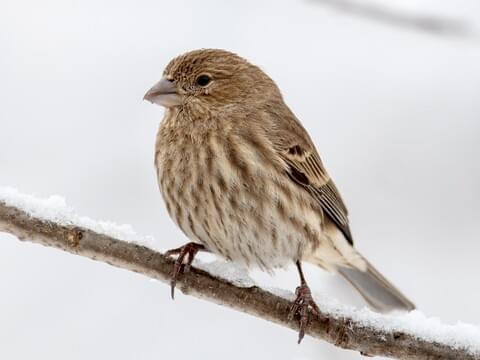
House Finches, originally foreign to Florida, have made the state their permanent home. With no migration habits, they are included in 7% of summer birding checklists and 4% of winter ones.
Female House Finches sport an all-over brown-streaked plumage, whereas males feature a red head and breast, with the rest of their bodies predominantly brown-streaked.
Scientific name: Haemorhous mexicanus Dimensions: Length: 5.1-5.5 inches (13-14 cm) Weight: 0.6-0.9 ounces (16-27 g) Wingspan: 7.9-9.8 inches (20-25 cm) Initially found only in the western US, House Finches were introduced to the eastern states and have thrived, even edging out the Purple Finch in some areas.
These birds are typically found in parks, farms, at the edges of forests, and visiting backyard feeders. They often gather in noisy groups that are quite conspicuous.
To draw House Finches to your backyard feeders, use black oil sunflower seeds or nyjer seeds, served in tube feeders or platform feeders.
12. House Sparrow
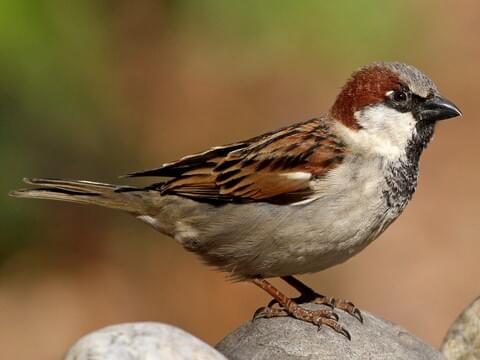
House Sparrows, an exotic species, have adapted well to life in Florida. They are non-migratory and feature on 6% of summer and 3% of winter bird-watching checklists for the region.
This species, originally foreign, has flourished to become one of the most ubiquitous birds in the area. They have gray and brown heads with white cheeks, while their backs are black and brown, and bellies are gray.
Scientific name: Passer domesticus Dimensions: Length: 5.9-6.7 inches (15-17 cm) Weight: 0.9-1.1 ounces (27-30 g) Wingspan: 7.5-9.8 inches (19-25 cm) House Sparrows maintain a constant presence across the US and southern Canada. They prefer dwelling near human habitats, displaying a certain level of fearlessness and may even feed from your hand.
Their diet consists mainly of grains and seeds, as well as discarded human food. While they may be considered pests due to their non-native status, they’re often sighted in backyards even when not fed directly.
To attract House Sparrows to your backyard, provide a variety of birdseeds, including millet, corn, and sunflower seeds.
13. American Goldfinch – Female

Primarily observed in the winter months in Florida, American Goldfinches grace the region mostly from November to April, featuring on 8% of the state’s winter bird-watching checklists.
The vibrant yellow and black hues of the male American Goldfinches in the spring make them a favorite among bird watchers. However, the females and males in winter present a duller brown appearance.
Scientific name: Spinus tristis Dimensions: Length: 4.3-5.1 inches (11-13 cm) Weight: 0.4-0.7 ounces (11-20 g) Wingspan: 7.5-8.7 inches (19-22 cm)
These charming birds inhabit most parts of North America and usually don’t migrate. Nevertheless, the ones breeding in Canada and the Midwest travel southwards to the US for the winter.
You can spot them foraging for sunflower, thistle, and aster plants in weedy fields and overgrown areas. They’re also commonplace in suburban spaces, parks, and backyard settings.
Draw American Goldfinches to your backyard by cultivating plants like thistles and milkweed. They’re frequent visitors to bird feeders, showing a preference for sunflower seeds and nyjer seeds.
14. Brown-headed Cowbird – Female

You can sight Brown-headed Cowbirds throughout the year in Florida. They make an appearance in around 4% of bird-watching checklists in both summer and winter. Primarily, they reside year-round in northern Florida, while in the southern part of the state, they are mainly observed during the winter months.
The female Brown-headed Cowbirds are mostly brown, slightly streaked, while the males, larger in comparison to females, exhibit black bodies, brown heads, and truncated tails.
Scientific name: Molothrus ater Dimensions: Length: 7.6-8.7 inches (19-22 cm) Weight: 1.3-1.8 ounces (42-50 g) Wingspan: 14.2 inches (36 cm)
Brown-headed Cowbirds are year-round dwellers in eastern US states, southern regions, and along the Pacific Coast. Yet, those breeding in the northern and western US states, along with Canada, migrate southwards during the winter.
These birds are often viewed as a bother due to their parasitic tendencies. They tend to destroy the eggs of smaller songbirds to lay their own in the nest, ensuring their chicks are fostered by other birds.
15. Northern Flicker
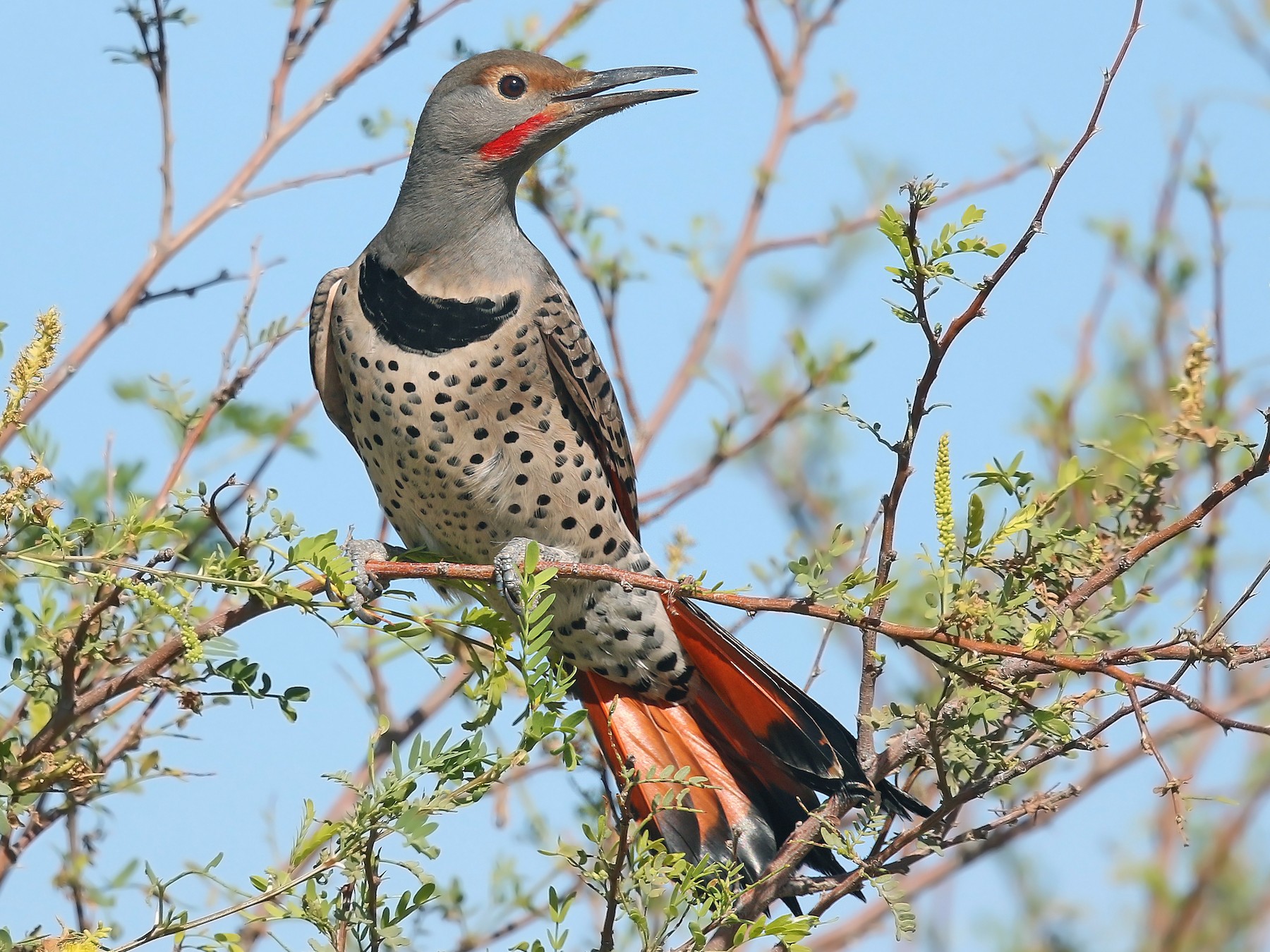
Northern Flickers are year-round inhabitants in Florida, appearing in 2% of summer bird-watching checklists and 4% of winter ones.
These large brown woodpeckers are distinguished by their black spots, a white patch on their rump visible during flight, and in males, a red mark on the back of the neck. Depending on their origin, Northern Flickers display red or yellow flashes in their wings and tails. Red-shafted birds are found in the west, while yellow-shafted ones inhabit the east.
Scientific Name: Colaptes auratus Dimensions: Length: 11.0-12.2 inches (28-31 cm) Weight: 3.9-5.6 ounces (110-160 g) Wingspan: 16.5-20.1 inches (42-51 cm)
Northern Flickers are present across the US throughout the year, and in Canada during the summer. Those that breed in Canada migrate southwards during the winter.
Their diet mainly consists of ants, beetles, fruits, and seeds, and they can often be observed on the ground, using their curved bill to dig for food.
Attract Northern Flickers to your backyard using suet. You may also spot other woodpecker species in Florida visiting your feeders.
16. Chipping Sparrow
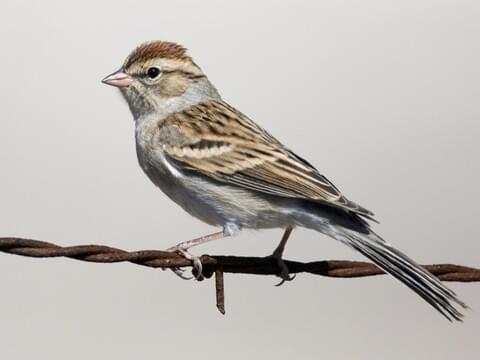
Chipping Sparrows are mostly observed in Florida during the winter months and are noted in about 7% of winter birdwatching records. While they can be seen year-round, their presence is more pronounced from mid-October to April.
These slender birds with elongated tails possess a gray belly and a back streaked with brown and black. They boast a rusty crown and a distinctive black line through their eyes. However, their colors tend to become more muted during winter.
Scientific Name: Spizella passerina Size: Length: 4.7-5.9 inches (12-15 cm) Weight: 0.4-0.6 ounces (11-16 g) Wingspan: 8.3 inches (21 cm)
Chipping Sparrows breed in the US and Canada during summer, then migrate to Mexico and Florida for the winter. However, some choose to remain throughout the year in the southern states.
You’re likely to spot Chipping Sparrows in small groups on open ground, and they’re known to frequent backyards in search of various types of birdseed.
To attract Chipping Sparrows to your backyard, offer seeds or cracked corn on open feeders like hoppers or platforms.
17. Savannah Sparrow
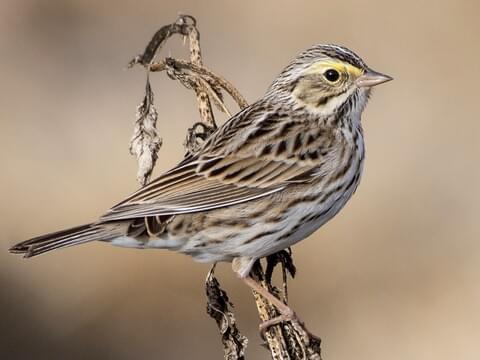
Savannah Sparrows are primarily winter visitors to Florida, with sightings common from September to June. They feature on 6% of the state’s winter birdwatching checklists.
Upon close inspection, the primarily brown Savannah Sparrow displays a distinctive yellow spot near its eye. It’s also recognized for its short tail and streaked brown coloration.
Scientific Name: Passerculus sandwichensis Size: Length: 4.3-5.9 inches (11-15 cm) Weight: 0.5-1.0 ounces (15-28 g) Wingspan: 7.9-8.7 inches (20-22 cm) Following their breeding season in Canada and the United States, Savannah Sparrows migrate to the southern states of the US and Mexico for the winter.
These sparrows typically forage for insects and spiders on the ground in open areas like grasslands during their breeding season, while seeds become their primary food source in winter.
Savannah Sparrows build nests on or near the ground, utilizing grass for construction. They lay up to six eggs, which typically hatch in approximately two weeks. The fledging of the young occurs within one to two weeks after hatching.
Although Savannah Sparrows don’t routinely visit bird feeders, they might be attracted to your yard if you maintain brush piles, grow tall grass, and are located near fields.
18. Cedar Waxwing

Primarily, Cedar Waxwings are observed in Florida during the winter season, featuring in about 4% of birdwatchers’ checklists during this period. The highest likelihood of sighting these birds in the state spans from November through May.
Cedar Waxwings exhibit a unique elegance, with their pale brown coloring on the head, chest, and crest that subtly transitions to gray on the back, wings, and tail. They flaunt a light yellow belly that intensifies towards the tail. These birds also display a thin black eye mask and vibrant red wingtips.
Scientific Name: Bombycilla cedrorum Size: Length: 5.5-6.7 inches (14-17 cm) Weight: 1.1 ounces (32 g) Wingspan: 8.7-11.8 inches (22-30 cm)
The northern half of the United States serves as a year-round home for Cedar Waxwings. However, those breeding in Canada usually migrate to the southern parts of the US for the winter.
Cedar Waxwings are known for their high-pitched calls and are commonly found in berry bushes, near streams, and in woodland areas.
To attract Cedar Waxwings to your backyard, consider planting native trees and shrubs that bear small fruits, such as serviceberry, dogwood, juniper, winterberry, and hawthorn. Offering fruit on platform feeders can also draw these elegant birds to your space.
19. Swamp Sparrow

Swamp Sparrows feature in 5% of birdwatching checklists in Florida during winter. These birds make Florida their home from September through May.
Distinguished by their rusty crowns and wings, Swamp Sparrows boast dark brown backs along with gray breasts and white throats. Their heads exhibit gray hues, with brown faces that have a distinct dark eye line. They also have a yellow tip at the end of their beak.
Scientific Name: Melospiza georgiana Size: Length: 4.7-5.9 inches (12-15 cm) Weight: 0.5-0.8 ounces (15-23 g) Wingspan: 7.1-7.5 inches (18-19 cm)
Swamp Sparrows predominantly inhabit the eastern regions. They breed in Canada, northeastern and north-central US states before migrating to the eastern and southern US states, as well as Mexico.
In line with their name, Swamp Sparrows prefer wetland habitats such as swamps, bogs, and coastal marshes. Their diet primarily consists of seeds and fruits, especially during winter, while they tend to consume more insects in the spring.
Swamp Sparrows typically nest in concealed locations amidst vegetation on or near the ground, using twigs, leaves, and cattails to construct their homes. The interior of the nest is lined with grass and other plant material for added comfort.
Swamp Sparrows are not frequent visitors to backyards, except during migration periods. They are more likely to be attracted to yards that boast abundant vegetation and water sources.
20. Northern Waterthrush

Northern Waterthrushes are seen in Florida mainly during the winter months, with sightings increasing significantly during migration seasons. These birds appear in about 4% of birdwatching checklists in spring and 7% in fall.
Resembling large thrushes, Northern Waterthrushes possess distinctive features shared by both sexes. They have brown heads adorned with bold, white eyebrows, dark brown backs, and white underparts heavily streaked with dark brown from their throats to their lower backs.
Scientific Name: Parkesia noveboracensis Dimensions: Length: 5.75 inches (15 cm) Weight: 0.8 ounces (23 g) Wingspan: 8.75 inches (22 cm)
Northern Waterthrushes typically breed in Canada, Alaska, and the northeastern US, post which they migrate to Mexico, Central and South America, and the Caribbean. Some individuals may choose to reside throughout the year in Central and South America.
These birds are often found in shaded, forested wetlands, such as swamps, thickets, and bogs. They have a propensity for calm or slow-moving water bodies in forests. In tropical areas during winter, they are commonly found among mangroves.
Northern Waterthrushes are both aquatic and terrestrial feeders. Thanks to their long legs, they are capable of wading through shallow waters to hunt for water beetles, mosquitoes, slugs, crustaceans, snails, and occasionally small fish. On land, they forage under leaves for caterpillars, moths, and ants.
When it comes to nesting, Northern Waterthrushes typically select spaces close to water, such as hollows or crevices. Whether it’s a moss-clad stump or a protruding bank, their nests are generally concealed amidst ferns.
21. Marsh Wren
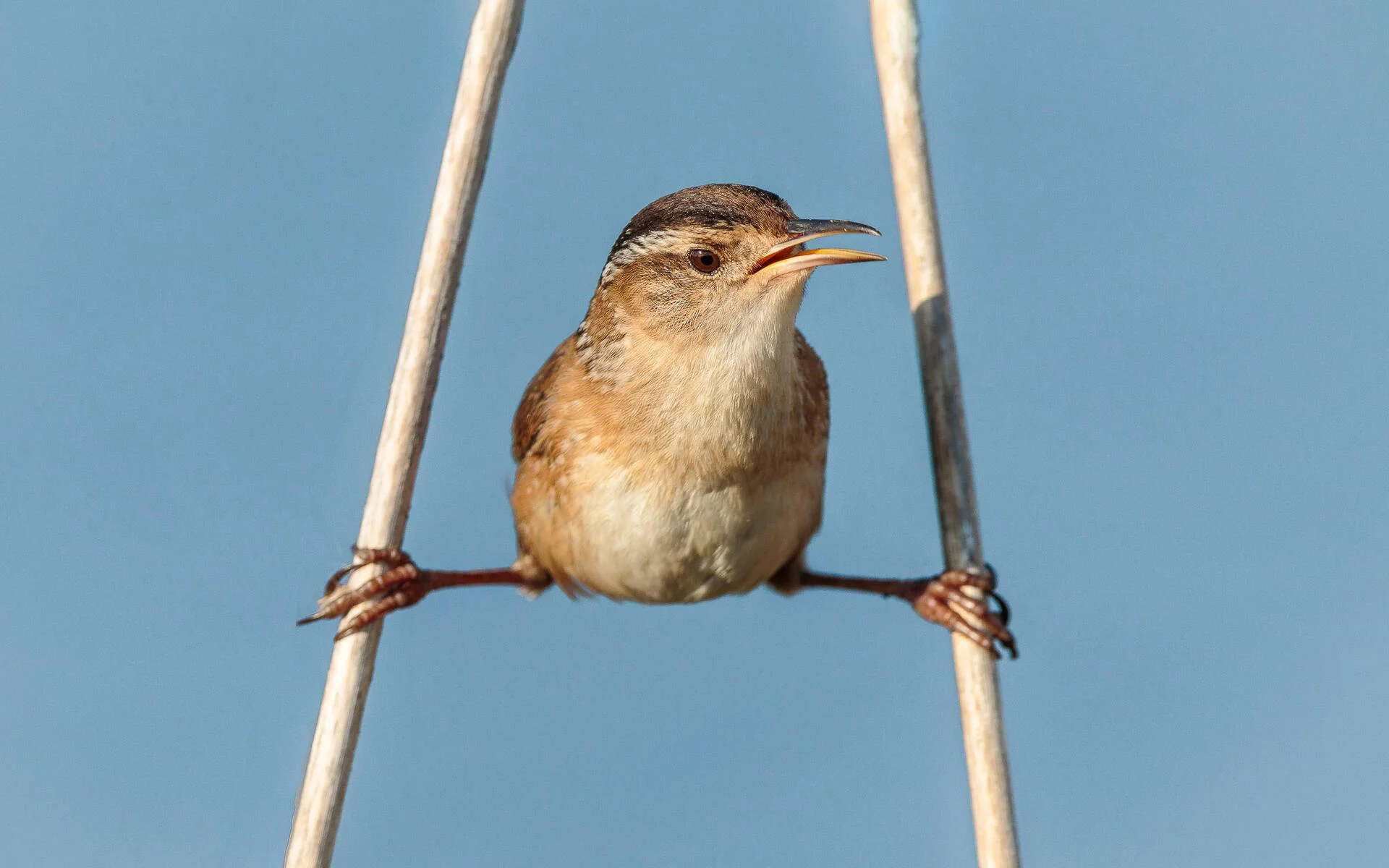
While Marsh Wrens can occasionally be spotted throughout the year, they are primarily observed in Florida during the winter months, with their prevalence peaking from October to December. They feature in approximately 2% of the birdwatching checklists.
Sporting the distinctive wren’s upright tail, Marsh Wrens exhibit a brown hue with their backs adorned with black and white streaks. Their underparts showcase a grayish-brown color. Both genders share the same physical characteristics.
In comparison to Sedge Wrens, Marsh Wrens possess a longer beak and lack shoulder stripes, despite their similar appearance.
Scientific Name: Cistothorus palustris Dimensions: Length: 3.9-5.5 inches (10-14 cm) Weight: 0.3-0.5 ounces (9-14 g) Wingspan: 5.9 inches (15 cm)
Marsh Wrens typically breed in the northern regions of the US and Central Canada, post which they migrate to the southern states and Mexico. Certain populations residing in the west and along the Atlantic Coast may stay put throughout the year. These birds can be sighted during their migration across the eastern US.
Habitually found in wetlands, Marsh Wrens are often seen clinging to reeds, with each foot grasping a separate stalk. Their presence can be challenging to notice visually, but their singing amidst the reeds, particularly at dawn and dusk, can be a giveaway. Their diet primarily consists of insects and spiders, which they glean off leaves near the water.
Marsh Wrens’ nests are characterized by their complete enclosure, save for a small entry point at the top. Constructed using reeds and grasses, these nests are meticulously woven together.
22. Hermit Thrush
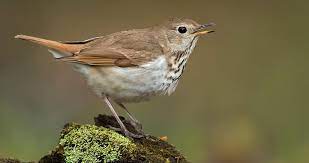
Hermit Thrushes are often seen in Florida during the winter months, making an appearance in about 2% of birdwatching checklists during this period. They are primarily observed from October through to April.
Exhibiting an upright posture, Hermit Thrushes are characterized by their stout bodies and extended tails. They feature a brown back and a white underbelly, with their throats and breasts adorned with spots.
Scientific Name: Catharus guttatus Dimensions: Length: 5.5-7.1 inches (14-18 cm) Weight: 0.8-1.3 ounces (23-37 g) Wingspan: 9.8-11.4 inches (25-29 cm)
Hermit Thrushes breed in regions including Canada, the northeastern United States, and the western part of the US. During migration, they can be spotted in the central states, eventually spending the winter along the Pacific Coast, in the southeastern states, and Mexico.
Foraging primarily on the forest floor in clearings, Hermit Thrushes scan the leaf litter for insects. During the winter, their diet expands to include berries.
Although they infrequently venture into backyards, their somewhat mournful song can be heard during the spring and summer seasons.
23. Song Sparrow

Song Sparrows are typically seen more often in Florida during the winter months, making their appearance on about 1% of birdwatching checklists. They are most frequently observed from September through to May.
While not as visually striking as some other backyard birds, Song Sparrows stand out with their mostly brown-streaked plumage and their almost incessant song, employed to woo mates during the spring and summer seasons.
Scientific Name: Melospiza melodia Dimensions: Length: 4.7-6.7 inches (12-17 cm) Weight: 0.4-1.9 ounces (12-53 g) Wingspan: 7.1-9.4 inches (18-24 cm)
Song Sparrows are year-round residents in the northern regions of the United States. Those that breed in Canada head south to the southern US states for the winter.
These birds are often found in open, wet, and shrubby areas, usually seen perched on a low shrub, singing. They are frequent visitors to backyard feeders.
Song Sparrows maintain a diverse diet, feasting on a wide range of insects and plants. Their menu includes beetles, caterpillars, midges, spiders, earthworms, and also plant foods like buckwheat, sunflower seeds, raspberries, wild cherries, blackberries, wheat, and rice.
Lure Song Sparrows to your backyard feeders with black oil sunflower seeds, cracked corn, and nyjer seeds on platform feeders.
Florida is home to a surprising number of sparrows. By learning their songs and fun facts about them, you can enhance your ability to identify them more easily.
24. Swainson’s Thrush

During the months of April to May and September to October, Swainson’s Thrushes are primarily observed in Florida. In spring, they are recorded in about 3% of checklists, while in the fall, they appear in approximately 9% of checklists.
Swainson’s Thrushes are medium-sized birds belonging to the thrush family. They have a light-colored underside with spotted chests and brown feathers on their back.
Scientific name: Catharus ustulatus Size: 6.3-7.5 inches (16-19 cm) in length Weight: 0.8-1.6 ounces (23-45 g) Wingspan: 11.4-12.2 inches (29-31 cm)
These thrushes can be found in forests where they search for insects and red fruits, such as blackberries, raspberries, huckleberries, and sumac, by foraging on the forest floor. They also include ants in their diet, and they feed other insects to their nestlings.
While they are mainly seen during their migratory periods in spring and fall across the contiguous United States, Swainson’s Thrushes breed in Canada and Alaska before embarking on their journey to Central and South America for the winter.
To attract Swainson’s Thrushes to your backyard, you can provide ground-level birdbaths and ensure there is ample tree and shrub cover available.
25. Rose-breasted Grosbeak – Female
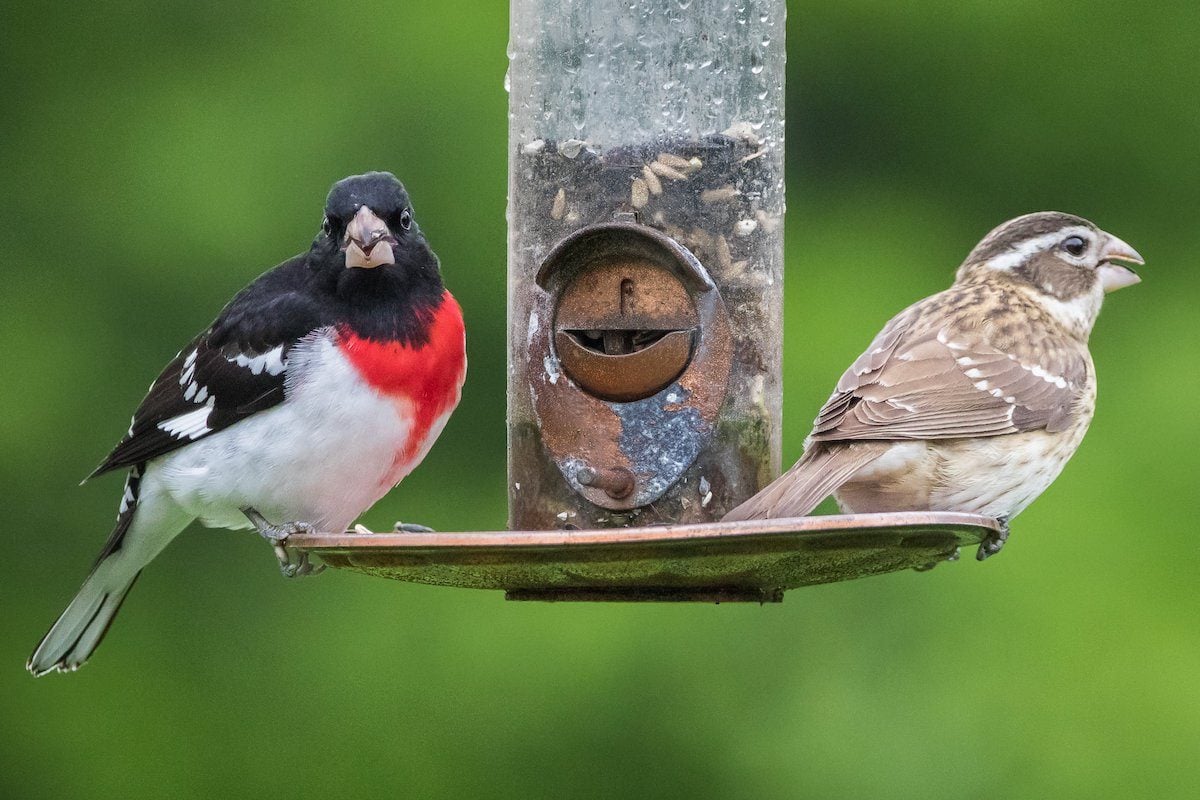
Migration brings the Rose-breasted Grosbeaks to Florida, particularly in April and October. These birds are noted in approximately 5% of checklists during these migration periods.
The female Rose-breasted Grosbeaks and young males exhibit a brown coloration with abundant streaks and a touch of yellow beneath their wings.
In contrast, the male Rose-breasted Grosbeaks are striking black-and-white birds with black heads and backs, white bellies, and vibrant red breasts. They also showcase a dash of red beneath their wings.
Scientific name: Pheucticus ludovicianus Size: 7.1-8.3 inches (18-21 cm) in length Weight: 1.4-1.7 ounces (39-49 g) Wingspan: 11.4-13.0 inches (29-33 cm)
Rose-breasted Grosbeaks breed in the northeastern states of the US, the Midwest, and southern and central Canada. During migration, they can be observed in the southeastern states of the US. Throughout winter, they reside in Mexico, Central America, and the Caribbean.
These birds can be found in forests, parks, and even backyard settings, where they search for insects, berries, and seeds.
Rose-breasted Grosbeaks construct their nests on low tree branches using loosely-formed twigs, grass, and plant materials. Each nest typically contains around five eggs, which take approximately two weeks to hatch. After hatching, both parents take turns incubating the eggs.
To attract Rose-breasted Grosbeaks to your backyard, provide them with sunflower seeds and peanuts as a food source.
26. White-throated Sparrow
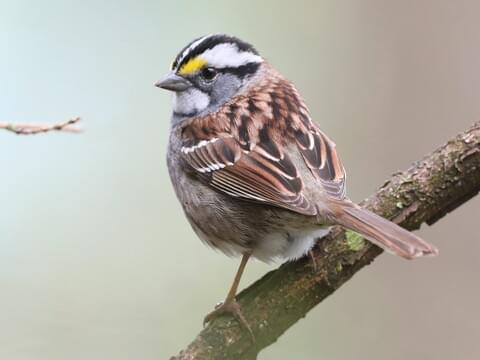
Florida becomes a winter home for White-throated Sparrows. Their arrival begins as early as October, and while some may stay until July, the prime months to spot them are from November to April.
Identifiable by their unique features, White-throated Sparrows possess a black and white striped head, a bright white throat, and a touch of yellow between their eye and bill. Their backs exhibit a brown coloration, while their underparts appear gray.
Scientific name: Zonotrichia albicollis Size: 6.3-7.1 inches (16-18 cm) in length Weight: 0.8-1.1 ounces (22-32 g) Wingspan: 7.9-9.1 inches (20-23 cm)
White-throated Sparrows are migratory birds that primarily breed in Canada. However, they embark on a journey southward during winter, making their way to the eastern and southern states of the US, as well as the Pacific Coast.
These sparrows can be found on the ground within forests, woodlands, and along the edges of wooded areas, often forming sizable flocks.
Their diet primarily consists of grass and weed seeds, along with fruits like grapes, sumac, mountain ash, blueberries, blackberries, and dogwood. During the summer months, they also consume numerous insects found on the forest floor.
To attract White-throated Sparrows to your backyard, provide millet and black oil sunflower seeds on platform feeders.
27. Louisiana Waterthrush

While a few Louisiana Waterthrushes can be observed throughout the year, their main presence in Florida occurs during migration periods from March to April and July to September.
In terms of appearance, Louisiana Waterthrushes may not display the vibrant colors seen in other warbler species. They possess a brown upper body and a pale underside. One distinctive feature is their white eyebrow stripe, accompanied by long pink legs.
Scientific name: Parkesia motacilla Size: 5.9-6.1 inches (15-15.5 cm) in length Weight: 0.6-0.8 ounces (18.2-22.9 g) Wingspan: 9.4-10.6 inches (24-27 cm)
Louisiana Waterthrushes breed in the eastern states of the US and can be observed in the southeastern region during migration. They spend their winter months in Mexico, Central America, and the Caribbean, returning in early spring.
These waterthrushes can be found along streams and flowing water in wooded areas, where they hunt for insects, vertebrates, and larvae.
The nests of Louisiana Waterthrushes are situated along stream banks, often concealed among roots or beneath logs. They construct their nests using leaves, pine needles, and other plant materials, held together with mud.
28. Wood Thrush

Wood Thrushes are typically observed in Florida during migration periods in April and October, although some individuals may be occasionally spotted throughout the year.
With their plump bodies, Wood Thrushes feature white bellies adorned with black spots, giving them a slightly amusing appearance. They have brown feathers on their back, along with reddish hues on the crown and upper back.
Scientific name: Hylocichla mustelina Size: 7.5-8.3 inches (19-21 cm) in length Weight: 1.4-1.8 ounces (40-50 g) Wingspan: 11.8-13.4 inches (30-34 cm)
Wood Thrushes undertake remarkable migrations, flying from eastern states of the US across the Gulf of Mexico in a single night, until they reach their wintering grounds in Central America.
These birds are adept at concealing themselves, often foraging amidst leaf litter in search of insects like beetles and flies. They prefer mature forests as their habitat. During the spring season, their melodious song, reminiscent of a flute, can be heard echoing through the woods.
29. White-crowned Sparrow
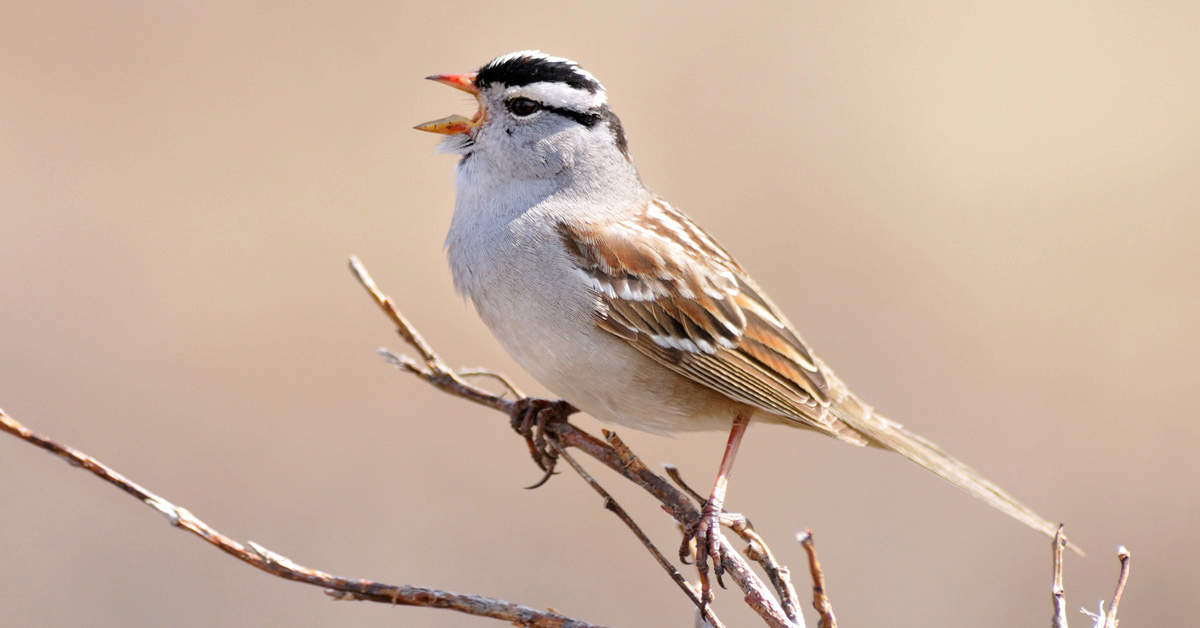
White-crowned Sparrows are not particularly common in Florida, but they can be observed during the winter season. Their presence in the state spans from September until July, with the prime months for sightings being November to March.
These sparrows are characterized by their larger size, grayish coloration, long tails, small bills, and striking black and white head stripes.
Scientific name: Zonotrichia leucophrys Size: 5.9-6.3 inches (15-16 cm) in length Weight: 0.9-1.0 ounces (25-28 g) Wingspan: 8.3-9.4 inches (21-24 cm)
White-crowned Sparrows breed in Alaska and the arctic regions of Canada before migrating southward to the lower 48 states and Mexico for the winter. However, some individuals may remain year-round along the Pacific Coast and in mountainous regions of the western US.
These sparrows can be found in weedy fields, along roadsides, forest edges, and even in residential yards, where they forage for seeds from weeds, grasses, as well as fruits like elderberries and blackberries.
White-crowned Sparrows build their nests using twigs, grass, moss, and pine needles. These nests are typically located low to the ground in shrubs or, in tundra habitats, directly on the ground. They lay up to seven eggs, which take around two weeks to hatch, and the chicks fledge in approximately nine days.
To attract White-crowned Sparrows to your backyard, provide sunflower seeds as a food source, and they will also feed on seeds dropped by other birds at the feeders.
30. Pine Siskin

Pine Siskins are winter visitors to Florida, beginning their arrival in October and some staying until May. However, the prime months to spot them are from February to April.
These small finches, known as Pine Siskins, feature brown plumage with noticeable yellow streaks on their wings and tails. They possess forked tails, pointed wings, and short, pointed bills.
Scientific name: Spinus pinus Size: 4.3-5.5 inches (11-14 cm) in length Weight: 0.4-0.6 ounces (12-18 g) Wingspan: 7.1-8.7 inches (18-22 cm)
Pine Siskins are year-round residents in pine forests of the western states and along the Canadian border. Some individuals also breed in Canada before migrating south for the winter season.
Depending on the availability of pine cone crops, they can be found across a significant portion of North America. True to their name, Pine Siskins primarily feed on seeds from coniferous trees. However, they also consume young buds and seeds from grasses and weeds.
To attract Pine Siskins to your backyard, provide thistle and nyjer feeders, as they are particularly fond of these seeds. Additionally, they will be enticed by black oil sunflower seeds and suet.
31. Field Sparrow
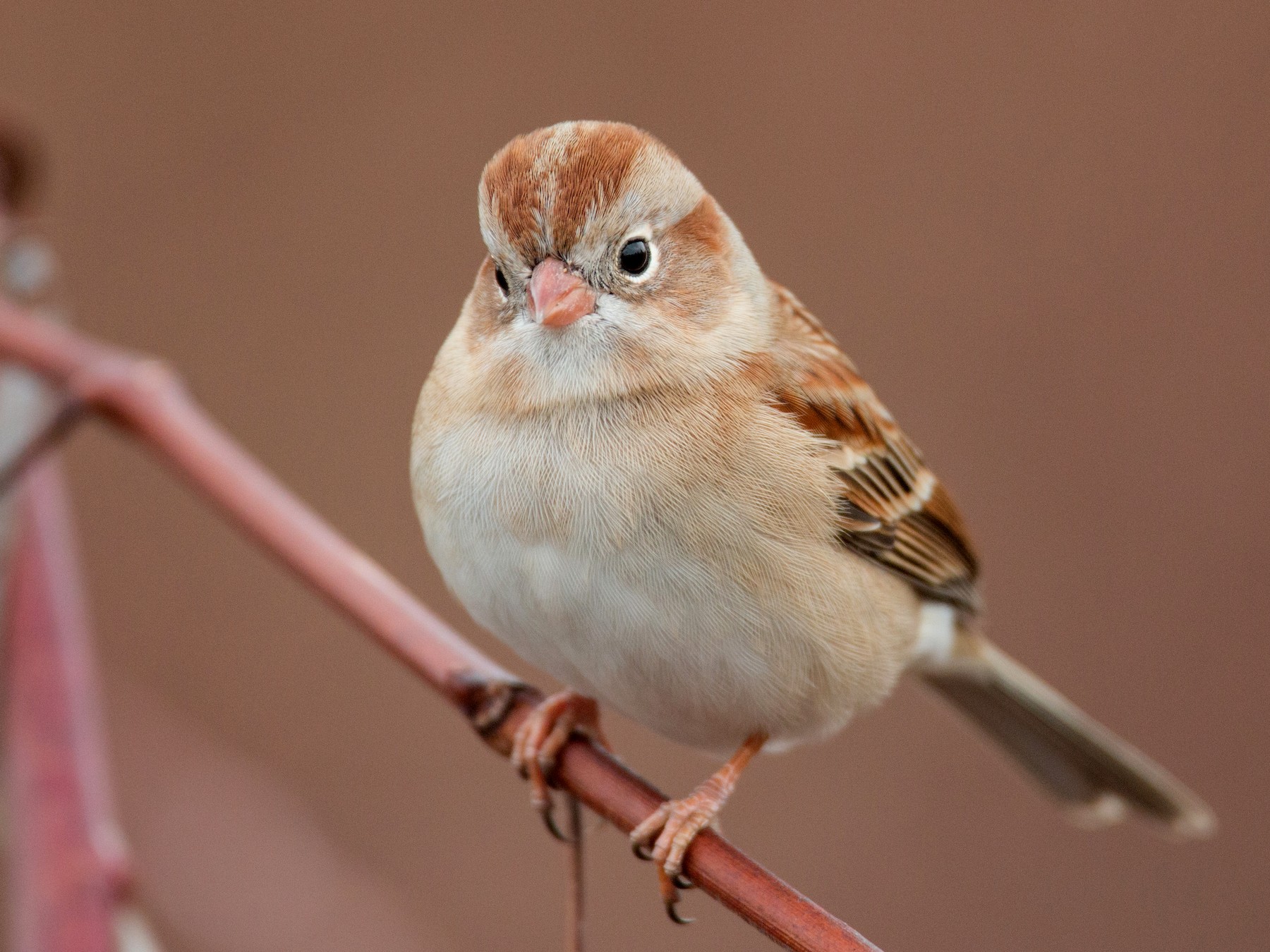
Field Sparrows can be observed in Florida throughout the year, but they are more commonly seen during the winter months, from November to March.
These small and slender birds, known as Field Sparrows, display brown backs streaked with black. Their undersides have a gray coloration, including their heads, while they feature a reddish crown and a pink bill.
Scientific name: Spizella pusilla Size: 4.7-5.9 inches (12-15 cm) in length Weight: 0.4-0.5 ounces (11-15 g) Wingspan: 7.9 inches (20 cm)
Field Sparrows are year-round residents in eastern states of the US. However, those that breed in the Midwest migrate southward for the winter season.
During the breeding season, male Field Sparrows can be easily located as they sing their melodious songs from perches in the early mornings. Outside of that period, they quietly feed on weeds and seeds, often inhabiting abandoned fields. Due to their shy nature, they can be easily overlooked.
The nests of Field Sparrows are initially constructed on the ground for the first brood. As the breeding season progresses, they build nests at higher locations. These nests are made from grass, and they typically lay up to five eggs, which take approximately two weeks to hatch. Once hatched, the young sparrows fledge in about a week.
To attract Field Sparrows to your backyard, provide cracked corn, hulled sunflower seeds, and millet as food sources.
32. Purple Finch – Female

Purple Finches are primarily observed in northern parts of Florida during the winter season, spanning from October to mid-May.
Female Purple Finches exhibit brown-streaked plumage all over their bodies, while males boast reddish-purple heads and breasts, with more brown tones on their backs and wings, and a paler belly. They bear a resemblance to House Finches but have a redder coloration, particularly on the upper part of their backs.
Scientific name: Haemorhous purpureus Size: 4.7-6.3 inches (12-16 cm) in length Weight: 0.6-1.1 ounces (18-32 g) Wingspan: 8.7-10.2 inches (22-26 cm)
Purple Finches breed in Canada and migrate to overwinter in eastern states of the US. However, they can be found year-round in the northeastern region and along the Pacific coast.
These finches can be found in evergreen forests, where they feed on seeds, buds, nectar, and berries.
Nests of Purple Finches are situated high up in trees, constructed with twigs, barks, weeds, and moss. Typically, they contain three to five eggs, which are incubated by the female for a period of thirteen days.
To attract Purple Finches to your backyard, provide black oil sunflower seeds as a food source.
33. Winter Wren
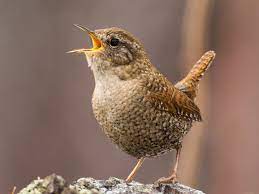
While Winter Wrens are not commonly sighted in Florida, they are recognized as regular visitors to the northern part of the state during the winter season.
Winter Wrens are small and plump brown birds, displaying darker barring on their wings, tail, and belly. They have a paler eyebrow stripe and short tails, which they keep upright. Both males and females have similar appearances.
Winter Wrens closely resemble Pacific Wrens, and they were once considered the same species. However, they are now classified as distinct species and have different songs.
Scientific name: Troglodytes hiemalis Size: 3.1-4.7 inches (8-12 cm) in length Weight: 0.3-0.4 ounces (8-12 g) Wingspan: 4.7-6.3 inches (12-16 cm)
During winter, Winter Wrens can be found in eastern states of the US, while they spend their summers in northeastern US states and Canada.
To spot Winter Wrens, search for them hidden within tangled undergrowth in forests and even backyards. They feed on insects and spiders, foraging by rummaging through fallen leaves and decaying bark.
Nests of Winter Wrens are constructed with twigs, moss, and grass, woven together into a rounded shape with a small opening. They typically lay 1 to 9 eggs, with hatching taking around two to two and a half weeks, followed by fledging.
To attract Winter Wrens to your backyard, provide native plants and create dense vegetation, as these features will be appealing to them.
34. Brown Creeper

Brown Creepers are infrequently observed in Florida, but they can be spotted from October to April, although not commonly.
These tiny songbirds, known as Brown Creepers, are challenging to detect as they blend into tree trunks with their streaked brown backs and white undersides.
Scientific name: Certhia americana Size: 4.7-5.5 inches (12-14 cm) in length Weight: 0.2-0.3 ounces (5-10 g) Wingspan: 6.7-7.9 inches (17-20 cm)
Brown Creepers do not migrate extensively, but they may move southward and to lower elevations during winter. They can be found in various regions, including Alaska, southern Canada, northeastern and eastern states of the US, extending down to Mexico and Central America. In some winters, they may also venture into central and southeastern states.
To spot these small birds, focus your attention on the tree trunks of mature woodlands with large trees, as this is where they can be found hunting for insects and larvae hidden within the bark.
Unlike nuthatches, which typically face down the tree trunk, Brown Creepers work their way up the tree, facing upwards.
Instead of singing, these songbirds emit a high-pitched piercing call that aids in locating their presence.
35. Spotted Towhee
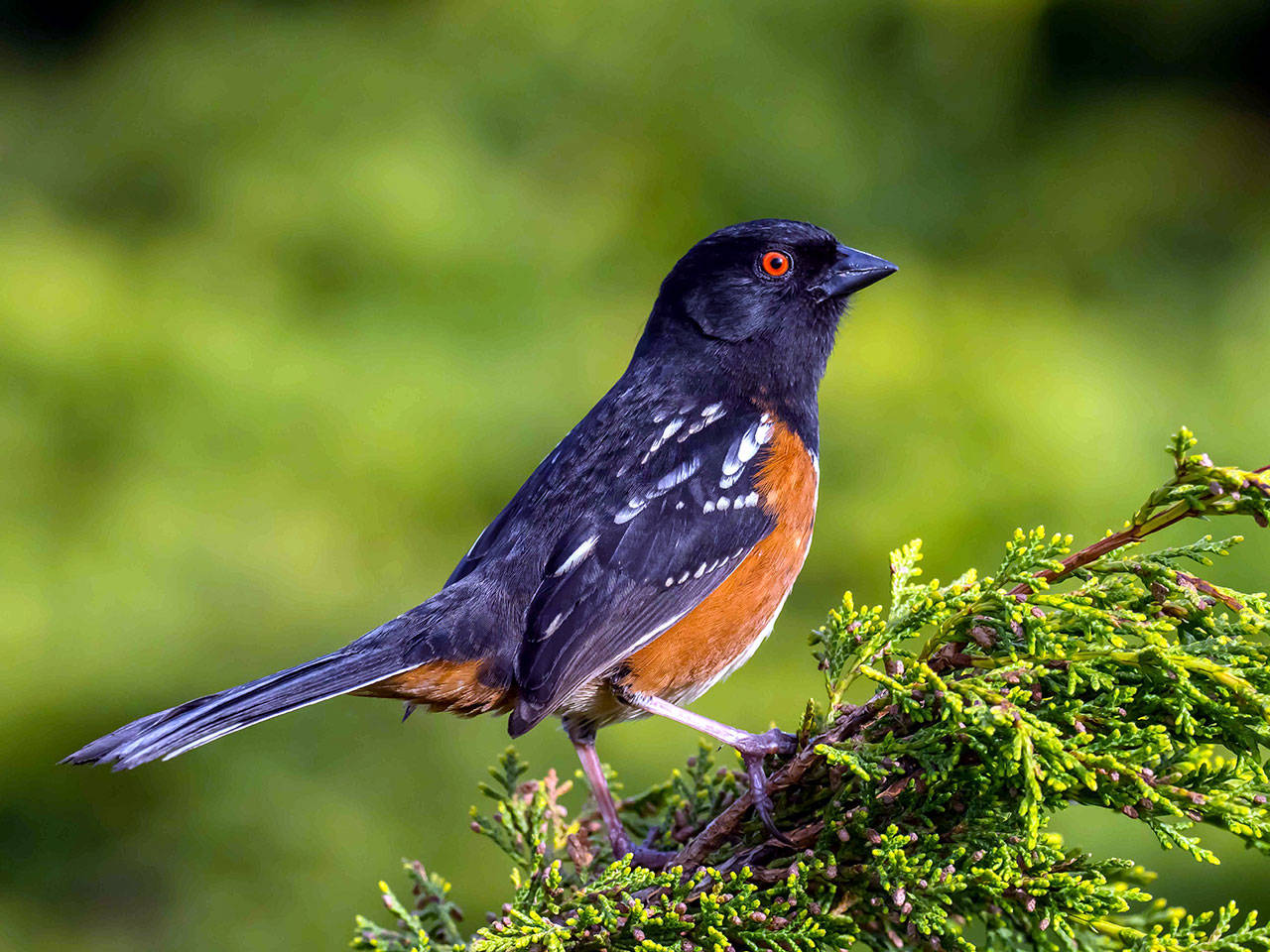
Spotted Towhees are considered rare or accidental species in Florida, but on occasion, they can be spotted during migration.
These large sparrows, known as Spotted Towhees, exhibit distinct coloration between males and females. Males have black heads, throats, and backs, while females showcase brown plumage. Both genders feature reddish-brown sides, white bellies, white spots on their wings and back, and long tails.
Scientific name: Pipilo maculatus Size: 6.7-8.3 inches (17-21 cm) in length Weight: 1.2-1.7 ounces (33-49 g) Wingspan: 11.0 inches (28 cm)
Spotted Towhees primarily inhabit western states of the US. However, those from inland areas in the northern region migrate southward to Texas after breeding.
These towhees can be found on the ground, often amidst dense tangles of shrubs, where they scratch around in search of insects. Their diet includes beetles, crickets, grasshoppers, caterpillars, wasps, bees, as well as acorns, berries, and seeds.
Nests of Spotted Towhees are typically situated on or near the ground and constructed using leaves, stems, bark, and lined with softer materials. They lay up to six eggs, which hatch after approximately two weeks, and the young ones fledge around ten days later.
To attract Spotted Towhees to your yard, leaving overgrown borders can provide them with suitable habitat. They may visit platform feeders or ground feeders if provided with Black Oil Sunflower seeds, Hulled Sunflower seeds, Cracked Corn, Millet, and Milo as food options.
36. Golden-crowned Sparrow

Golden-crowned Sparrows are considered rare species in Florida, but sightings were reported around Indian River Lagoon Preserve State Park in 2021.
These sparrows display grayish-brown undersides with streaked brown feathers on their backs. Their heads are adorned with a black crown and a vibrant yellow forehead.
During the winter season, their colors become duller, with the crown taking on a browner hue, and the yellow forehead losing some of its brightness.
Scientific name: Zonotrichia atricapilla Size: 5.9-7.1 inches (15-18 cm) in length Weight: 1.1-1.2 ounces (30-33 g)
Golden-crowned Sparrows breed in Alaska and western Canada before embarking on their migration to the West Coast for the winter.
These sparrows can be found in weedy fields, where they scratch the ground in search of seeds such as dock, sumac, and geranium. Additionally, they feed on fruits like apples, grapes, elderberries, and olives. Insects, including ants, beetles, butterflies, and termites, also contribute to their diet.
Nests of Golden-crowned Sparrows are typically situated on the ground and constructed using twigs, moss, and leaves. They line the nests with softer materials like animal hair, grass, and feathers.
To attract Golden-crowned Sparrows to your backyard, provide seeds on ground feeders or consider planting native plants that produce fruits.
37. Bewick’s Wren

Bewick’s Wrens are considered accidental species in Florida, and based on records, the last reported sightings occurred around Gulf Islands National Seashore in 2013.
These wrens feature brown backs and possess long gray upright tails with darker barring. Their bellies are gray, and they exhibit a distinctive white stripe above the eye.
Scientific name: Thryomanes bewickii Size: 5.1 inches (13 cm) in length Weight: 0.3-0.4 ounces (8-12 g)
Bewick’s Wrens are year-round residents of southern and western states, with some minor movements observed during winter.
You can encounter Bewick’s Wrens in scrublands, thickets, and open woodlands, as they hop from branch to branch, showcasing their characteristic tail-flicking behavior. They primarily feed on insects and larvae, including bees, bugs, caterpillars, and beetles.
Nests of Bewick’s Wrens are typically situated on rock ledges, within old woodpecker nests, nest boxes, or even in crevices of buildings. These nests take on a cup shape and are constructed using sticks and grasses, with a softer lining. They lay 3 to 8 eggs, with hatching taking approximately two weeks, followed by another two weeks until the young ones fledge.
To attract Bewick’s Wrens to your backyard, provide suet, mealworms, and hulled sunflower seeds as food options.
38. American Tree Sparrow
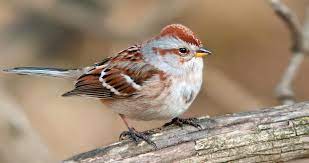
American Tree Sparrows are incredibly rare in Florida and are considered accidental species within the state. The most recent sightings were documented around Everglades National Park in 2017.
These sparrows possess a distinct appearance, characterized by their long tails, brown-streaked plumage, rusty caps, gray faces, and a rusty eye line.
Scientific name: Spizelloides arborea Size: 5.5 inches (14 cm) in length Weight: 0.5-1.0 ounces (13-28 g) Wingspan: 9.4 inches (24 cm)
American Tree Sparrows are known as winter birds in the United States and summer birds in Canada. They breed in the northern regions of Canada and Alaska, then migrate to various US states for the winter, with the exception of the Pacific and Gulf Coasts.
You can spot American Tree Sparrows foraging in small flocks within weedy fields and underneath bird feeders.
Nests of American Tree Sparrows are typically located on or near the ground and constructed using twigs, grass, and moss. They lay approximately five eggs, which hatch in just under two weeks, and the young birds take a little over a week to fledge.
To attract American Tree Sparrows to your backyard, provide platform feeders stocked with black oil sunflower seeds, nyjer, cracked corn, and millet. They also feed on seeds that fall to the ground from tube feeders.
How Frequently Brown Birds Are Spotted In Florida In Summer And Winter
Checklists serve as valuable tools to discover the bird species commonly observed in a particular state. These comprehensive lists provide insights into the prevalent brown birds frequently reported on eBird checklists during both summer and winter seasons in Florida.
